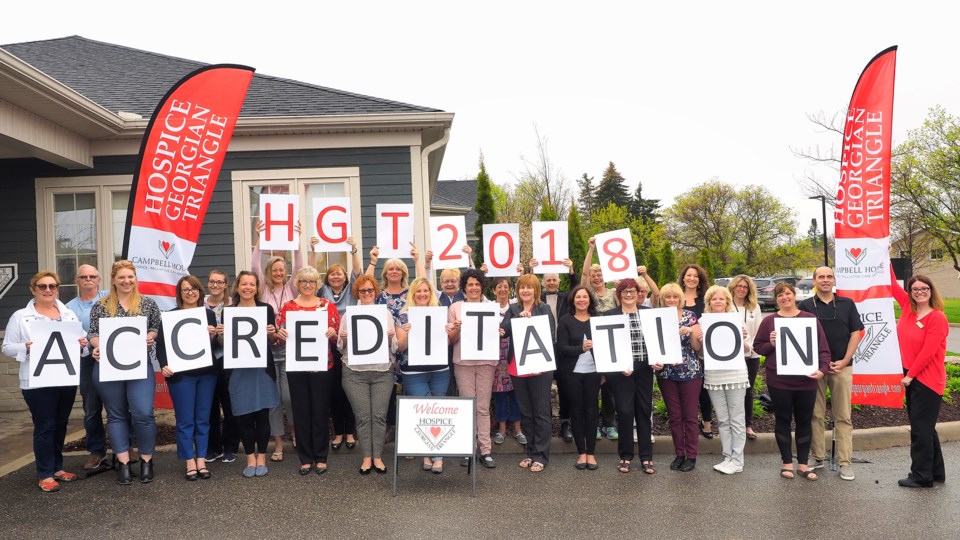New funding from the province means 10 new hospice beds in the North Simcoe-Muskoka Local Health Integration Network (NSM LHIN), but not for Collingwood.
There are still four beds and rooms built but unused at Hospice Georgian Triangle (HGT), which operates Campbell House Hospice. The beds were complete in 2017, but still don’t have operational funding.
According to Kathleen Bain, director of communications for NSM LHIN, there’s no provincial funding for additional beds right now.
The issue came up during the provincial election, with local candidates raising the unfunded beds during debates. The province did allocate funding for 193 new hospice beds, and the NSM LHIN received funds for 10 of those beds.
“Operating funds were directed to support five beds in the North Simcoe area, and five in Couchiching (Orillia area), based on the provincial analysis and by need in the LHIN as they didn’t have any,” said Bain.
HGT does receive operational funding for six beds, and the board of directors continues to propose creative ways to use the remaining unfunded beds. So far, those proposals have been unsuccessful.
Most recently, the board submitted a proposal backed by the Collingwood General and Marine Hospital for a pain and symptom management system.
Essentially, HGT was proposing opening the four beds for use by patients who don’t yet qualify for a hospice stay, or who are palliating at home, but experience a pain or symptom crisis and need a medical facility for treatment. Instead of going to the hospital and perhaps staying there for a couple days, the patients could come to HGT for the pain and symptom management and stay overnight as necessary for short-term stays.
HGT board of directors chairperson, Linda McLeod, said the proposal was intended to not only use the four empty beds at hospice, but to relieve the pressure on both the emergency room and the acute care beds at CGMH.
“It’s a type of respite,” said McLeod. “We have people in hospital who are palliative, who stay there for long periods. They need treatment, but they are not ready to die yet. We could do that [give treatment] and get them home.”
McLeod said HGT is suited for that kind of care, since the staff are experienced in terminal illness and pain and symptom management, and the building is designed to be more like a home than an institution to provide patients with a more relaxed environment.
“People do actually relax coming in, because it feels like the pressure is off of them,” said McLeod, adding there’s a difference between acute care for a hospital patient and pain and symptom management for palliative patients.
According to Norah Holder, president and CEO of CGMH, the hospital and a “strong physician base” is supportive of the proposal by HGT to the NSM LHIN.
“It was most definitely a joint submission … it’s an excellent opportunity we hope to see come to fruition,” said Holder.
In fact, the CGMH has made a point of seeking out partnerships with other healthcare providers in the community with the aim of improving patient care in and out of hospital. A recent initiative between CGMH and local midwives at Healthy Babies Happy Families to provide midwife postpartum care to mothers and babies delivered in hospital.
According to NSM LHIN, the HGT proposal can’t be funded and their hands are tied.
“The latest proposal submitted by HGT is not supported by legislation, and to [fund it] would be against the current laws,” said Bain. “We are working with our Ministry of Health and Long-Term Care colleagues to identify opportunities for expansion of the current pilot they have in Northern Ontario for this type of program. Our request for inclusion in the pilot has not been approved to date.”
The pilot program Bain is referring to is in place in Sudbury allowing a local hospice to provide respite beds for palliative patients who are getting care at home. The program is intended to provide respite for caregivers by allowing short-term respite stays for the palliative patient to relieve the caregiver of their responsibilities for a while. It’s not exactly the proposal submitted by HGT, but it’s the only instance in Ontario where a hospice is receiving funding for respite care.
Lynda Meeks, interim executive director of HGT, hopes the recent proposal helps spark a discussion around the current criteria and funding model for hospice in Ontario.
“Allowing palliative respite and palliative management outside of the eligibility criteria allows us to help more people,” she said.
McLeod said the HGT board isn’t giving up on finding a creative solution for the four unfunded beds.
“We’re trying to come up with something the LHIN can support,” she said. “We’ve worked well with them in the past and would like for that to happen again.”


